Epitaxial SiC Dosimeters and Flux Monitoring Detectors for Proton Therapy Beams
Abstract
1. Introduction
2. Materials and Methods
3. Experimental Results
4. Discussion
5. Conclusions
Author Contributions
Funding
Institutional Review Board Statement
Informed Consent Statement
Data Availability Statement
Conflicts of Interest
References
- IAEA—International Atomic Energy Agency. Absorbed Dose Determination in External Beam Radiotherapy: An International Code of Practice for Dosimetry based on Standards of Absorbed Dose to Water, Technical Reports Series No.398. 2000. Available online: https://www-pub.iaea.org/MTCD/Publications/PDF/TRS398_scr.pdf (accessed on 3 April 2023).
- Schüller, A.; Heinrich, S.; Fouillade, C.; Subiel, A.; De Marzi, L.; Romano, F.; Peier, P.; Trachsel, M.; Fleta, C.; Kranzer, R.; et al. The European Joint Research Project UHDpulse—Metrology for advanced radiotherapy using particle beams with ultra-high pulse dose rates. Phys. Med. 2020, 80, 134–150. [Google Scholar] [CrossRef] [PubMed]
- McManus, M.; Romano, F.; Lee, N.D.; Farabolini, W.; Gilardi, A.; Royle, G.; Palmans, H.; Subiel, A. The challenge of ionisation chamber dosimetry in ultra-short pulsed high dose-rate Very High Energy Electron beams. Sci. Rep. 2020, 10, 9089. [Google Scholar] [CrossRef]
- Chopra, V.; Dhoble, N.S.; Dhoble, S.J.; Poelman, D. New Challenges in Radiation Dosimetry and Possible Materials, Radiation Dosimetry Phosphors; Chapter 19, 2019 Woodhead Publishing Series in Electronic and Optical Materials; Woodhead Publishing: Sawston, UK, 2022; pp. 509–524. [Google Scholar] [CrossRef]
- Hattori, K.; Inaba, Y.; Kato, T.; Fujisawa, M.; Yasuno, H.; Yamada, Y.; Haga, Y.; Suzuki, M.; Zuguchi, M.; Chida, K. Evaluation of a New Real-Time Dosimeter Sensor for Interventional Radiology Staff. Sensors 2023, 23, 512. [Google Scholar] [CrossRef]
- Bruzzi, M. Novel Silicon Devices for Radiation Therapy Monitoring. Nucl. Instr. Meth. Phys. Res. 2016, 809, 105. [Google Scholar] [CrossRef]
- Bruzzi, M.; Bucciolini, M.; Pini, S.; Russo, S. Advanced materials in radiation dosimetry. Nucl. Instr. Meth. Phys. Res. 2002, 485, 172–177. [Google Scholar] [CrossRef]
- Klein, C.A. Bandgap Dependence and Related Features of Radiation Ionization Energies in Semiconductors. J. Appl. Phys. 1968, 39, 2029. [Google Scholar] [CrossRef]
- Bruzzi, M.; Sadrozinski, H.-F.W.; Seiden, A. Comparing radiation tolerant materials and devices for ultra rad-hard tracking detectors. Nucl. Instr. Meth. Phys. Res. 2007, 579, 754–761. [Google Scholar] [CrossRef]
- Bruzzi, M.; Nava, F.; Pini, S.; Russo, S. High quality SiC applications in radiation dosimetry. Appl. Surf. Sci. 2001, 184, 425–430. [Google Scholar] [CrossRef]
- Bruzzi, M.; De Angelis, C.; Scaringella, M.; Talamonti, C.; Viscomi, D.; Bucciolini, M. Zero-bias operation of polycrystalline chemically vapour deposited diamond films for Intensity Modulated Radiation Therapy. Diam. Rel. Mat. 2011, 20, 84–92. [Google Scholar] [CrossRef]
- Kagan, H.; Alexopoulos, A.; Artuso, M.; Bachmair, F.; Bäni, L.; Bartosik, M.; Beacham, J.; Beck, H.; Bellini, V.; Belyaev, V.; et al. Diamond detector technology, status and perspectives. Nucl. Inst. Methods Phys. Res. 2019, 924, 297–300. [Google Scholar] [CrossRef]
- Bäni, L.; Alexopoulos, A.; Artuso, M.; Bachmair, F.; Bartosik, M.; Beacham, J.; Beck, H.; Bellini, V.; Belyaev, V.; Bentele, B.; et al. Diamond detectors for high energy physics experiments. J. Instrum. 2018, 13, C01029. [Google Scholar] [CrossRef]
- De Napoli, M. SiC detectors: A review on the use of silicon carbide as radiation detection material. Front. Phys. 2022, 10, 769. [Google Scholar] [CrossRef]
- PTW-FreiburgGMBH, LorracherStr.779115, Freiburg, Germany. Available online: https://:www.ptw.de (accessed on 3 April 2023).
- Menichelli, D.; Scaringella, M.; Moscatelli, F.; Bruzzi, M.; Nipoti, R. Characterization of energy levels related to impurities in epitaxial 4H-SiC ion implanted p+n junctions. Diam. Rel. Mat. 2007, 16, 6–11. [Google Scholar] [CrossRef]
- Owens, A.; Peacock, A. Compound Semiconductor radiation Detectors. Nucl. Instr. Meth. Phys. Res. 2004, 531, 18–37. [Google Scholar] [CrossRef]
- Bruzzi, M.; Talamonti, C.; Calisi, N.; Caporali, S.; Vinattieri, A. First proof-of-principle of inorganic perovskites clinical radiotherapy dosimeters. APL Mater. 2019, 7, 051101. [Google Scholar] [CrossRef]
- Bruzzi, M.; Calisi, N.; Enea, N.; Verroi, E.; Vinattieri, A. CsPbCl3 inorganic perovskite thin-film detectors for real-time monitoring in protontherapy. Front. Phys. 2023, 11, 51. [Google Scholar] [CrossRef]
- Bruzzi, M.; Talamonti, C. Characterization of Crystalline CsPbBr3 Perovksite Dosimeters for Clinical Radiotherapy. Front. Phys. 2021, 9, 625282. [Google Scholar] [CrossRef]
- Bruzzi, M.; Gabelloni, F.; Calisi, N.; Caporali, S.; Vinattieri, A. Defective States in Micro-Crystalline CsPbBr3 and Their Role on Photoconductivity. Nanomaterials 2019, 9, 177. [Google Scholar] [CrossRef]
- Bruzzi, M.; Falsini, N.; Calisi, N.; Vinattieri, A. Electrically active defects in polycrystalline and single crystal metal halide perovskite. Energies 2020, 13, 1643. [Google Scholar] [CrossRef]
- Bruzzi, M.; Nava, F.; Russo, S.; Sciortino, S.; Vanni, P. Characterisation of silicon carbide detectors response to electron and photon irradiation. Diam. Rel. Mat. 2001, 10, 657–661. [Google Scholar] [CrossRef]
- Petringa, G.; Cirrone, G.A.P.; Altana, C.; Puglia, S.M.; Tudisco, S. First characterization of a new Silicon Carbide detector for dosimetric applications. IoP J. Instr. 2020, 15, C05023. [Google Scholar] [CrossRef]
- Yamaguchi, K.; Yanagisawa, R.; Osaki, K.; Ohki, Y.; Matsumura, A.; Sakai, M.; Makino, T.; Ohshima, T.; Kada, W. Linear energy transfer (LET) spectroscopy and relative biological effect estimation by SiC-based dosimeter at clinical carbon-beam cancer therapy field. J. Phys. Conf. Ser. 2022, 2326, 012015. [Google Scholar] [CrossRef]
- Christanell, M.; Tomaschek, M.; Bergauer, T. MedAustron 4H-silicon carbide as particle detector for high-intensity ion beams. IoP J. Instr. 2022, 17, C01060. [Google Scholar] [CrossRef]
- Tommasino, F.; Rovituso, M.; Fabiano, S.; Piffer, S.; Manea, C.; Lorentini, S.; Lanzone, S.; Wang, Z.; Pasini, M.; Burger, W.J.; et al. Proton beam characterization in the experimental room of the Trento Proton Therapy facility. Nucl. Inst. Meth. Phys. Res. 2017, 869, 15–20. [Google Scholar] [CrossRef]
- Nava, F.; Vanni, P.; Bruzzi, M.; Lagomarsino, S.; Sciortino, S.; Wagner, G.; Lanzieri, C. Minimum Ionizing and Alpha Particles Detectors Based on Epitaxial Semiconductor Silicon Carbide. IEEE Trans. Nucl. Sci. 2004, 51, 1. [Google Scholar] [CrossRef]
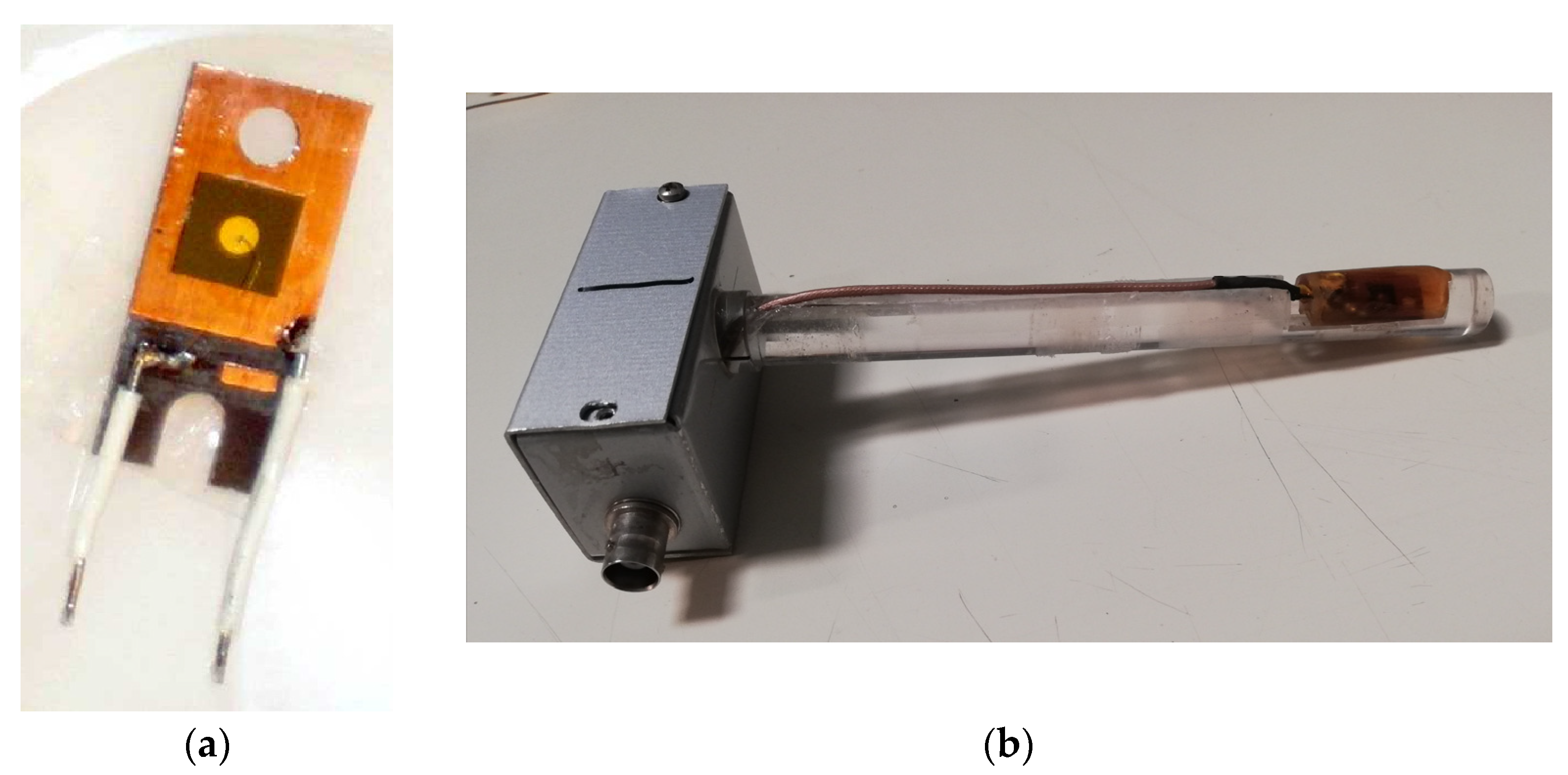
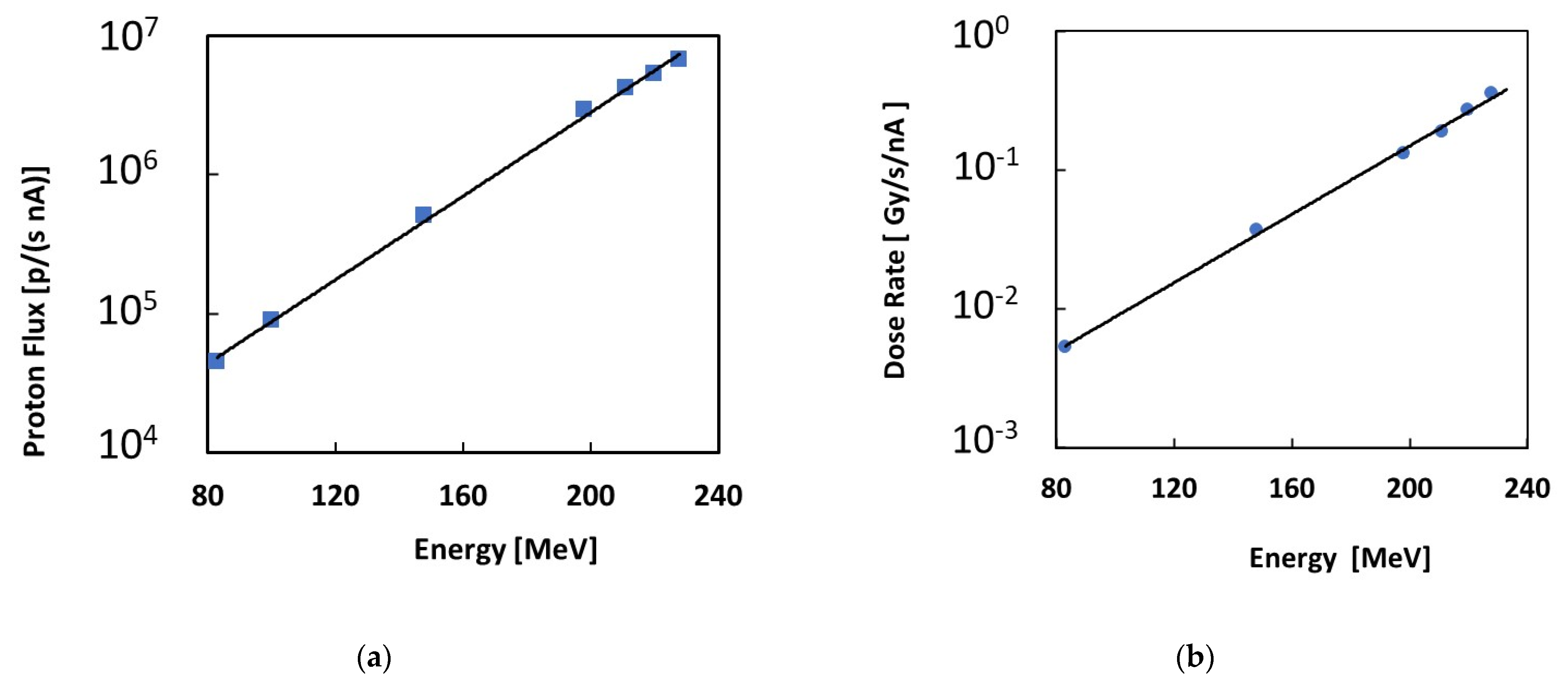
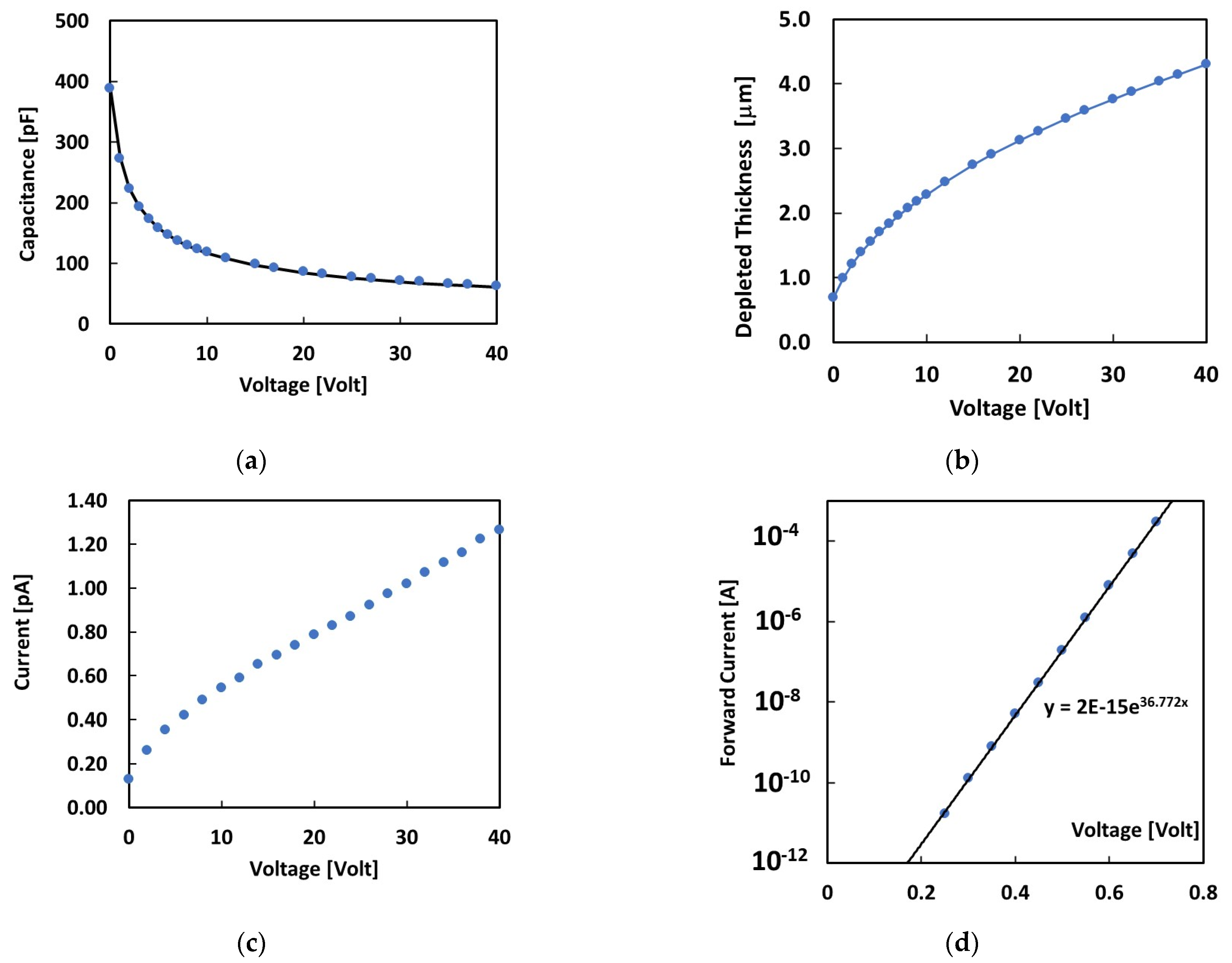

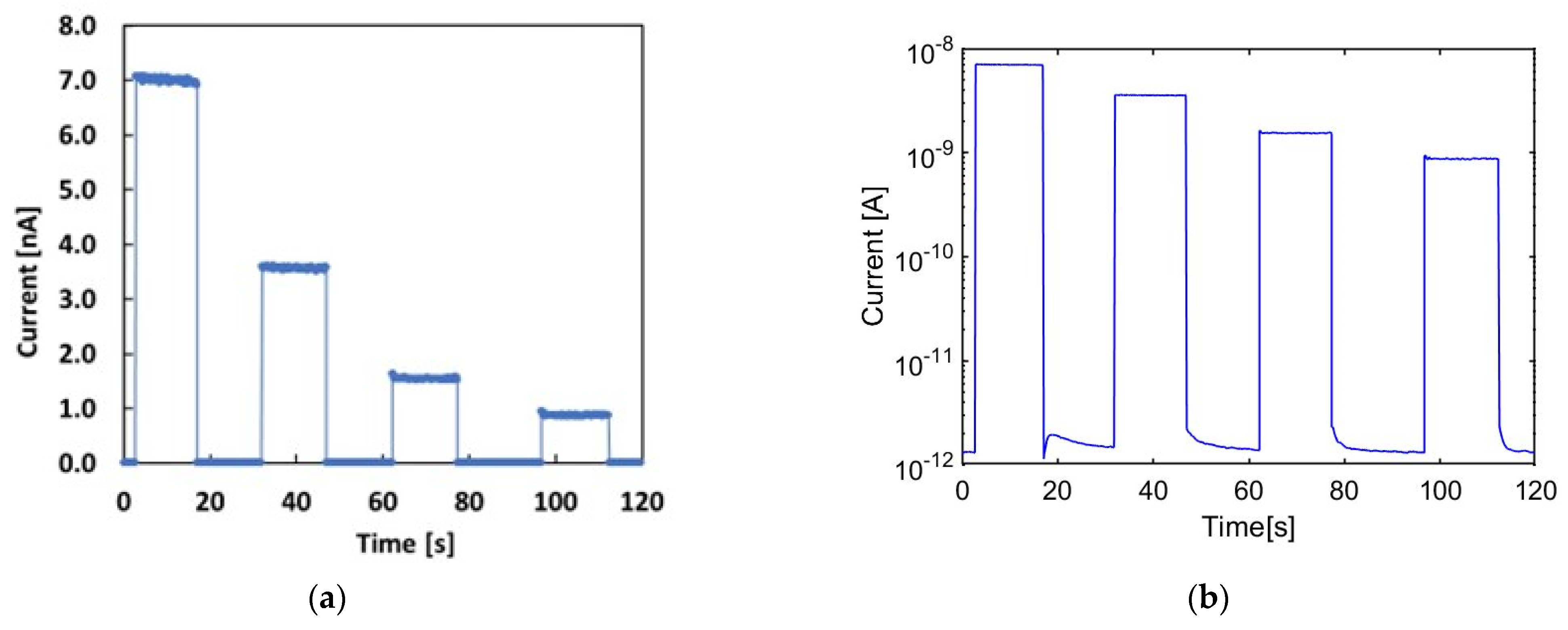
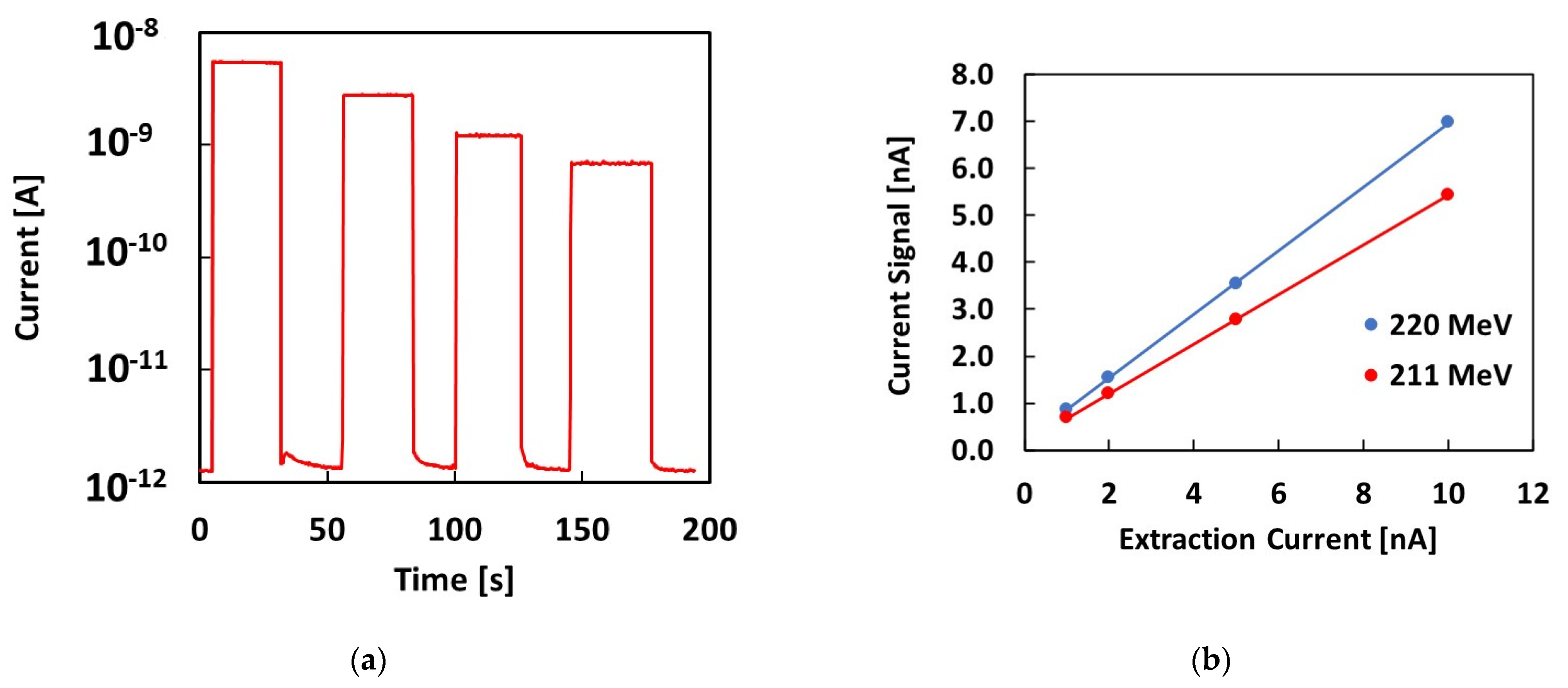

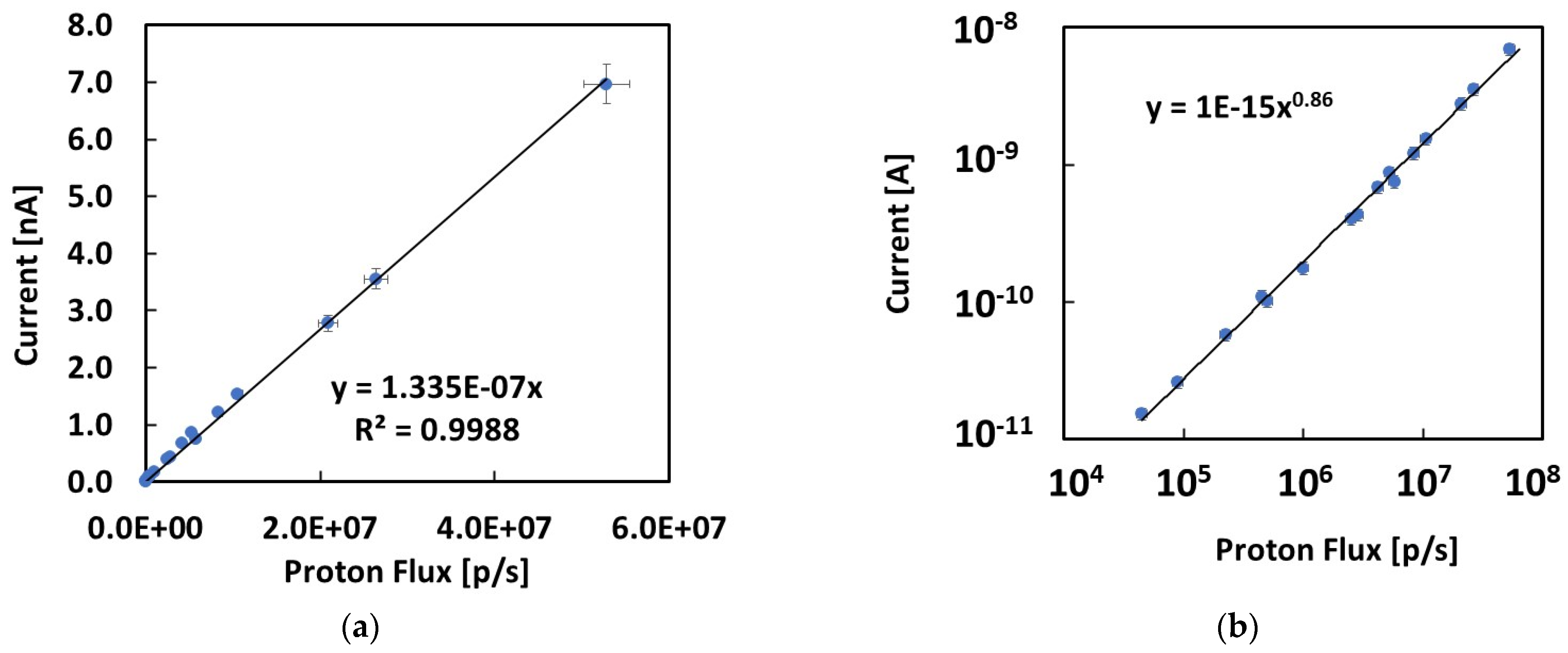
Disclaimer/Publisher’s Note: The statements, opinions and data contained in all publications are solely those of the individual author(s) and contributor(s) and not of MDPI and/or the editor(s). MDPI and/or the editor(s) disclaim responsibility for any injury to people or property resulting from any ideas, methods, instructions or products referred to in the content. |
© 2023 by the authors. Licensee MDPI, Basel, Switzerland. This article is an open access article distributed under the terms and conditions of the Creative Commons Attribution (CC BY) license (https://creativecommons.org/licenses/by/4.0/).
Share and Cite
Bruzzi, M.; Verroi, E. Epitaxial SiC Dosimeters and Flux Monitoring Detectors for Proton Therapy Beams. Materials 2023, 16, 3643. https://doi.org/10.3390/ma16103643
Bruzzi M, Verroi E. Epitaxial SiC Dosimeters and Flux Monitoring Detectors for Proton Therapy Beams. Materials. 2023; 16(10):3643. https://doi.org/10.3390/ma16103643
Chicago/Turabian StyleBruzzi, Mara, and Enrico Verroi. 2023. "Epitaxial SiC Dosimeters and Flux Monitoring Detectors for Proton Therapy Beams" Materials 16, no. 10: 3643. https://doi.org/10.3390/ma16103643
APA StyleBruzzi, M., & Verroi, E. (2023). Epitaxial SiC Dosimeters and Flux Monitoring Detectors for Proton Therapy Beams. Materials, 16(10), 3643. https://doi.org/10.3390/ma16103643






